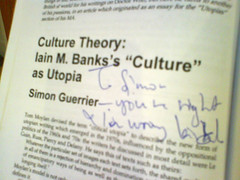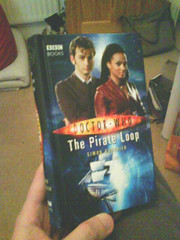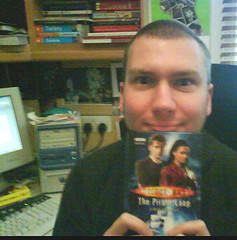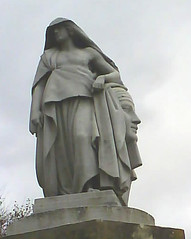The poster could be glimpsed in several episodes of The X Files, and it bore the legend, “I WANT TO BELIEVE”. Part of the drive of the show was Mulder trying to prove his weird shit to sceptical partner, Dana Scully. Long-suffering Scully would try to stop him wasting his life traipsing after any old nonsense… Her job was to insist on evidence and to make the X Files not look silly.
I was thinking of this as I finished The God Delusion. It’s odd, but prior to reading it for myself (and I’ve delayed ‘cos I knew it would need thinking about) I’ve sat through lots of earnest discussion of Dawkins and his book, with learned folk on both sides of the religious fence getting rather cross. It’s a little surprising – and disappointing – to discover that Dawkins himself addresses all the criticisms I have heard.
It’s a rather rambling series of thought experiments that not entirely systematically undermine belief. Dawkins addresses the continuity errors in the holy books, and the less savoury aspects contained within them, too. He discusses morality as distinct from religious doctrine. He has things to say about religious epiphanies and the voices religious folk hear in their heads. He explores the solace religion is meant to offer. And again and again he comes back to the harm that belief can do.
Throughout, there is a strict adherence to the idea of “truth”, where propositions are backed up by evidence. No, he admits, you can’t entirely disprove God’s existence, no more than you can disprove that Zeus and Hera are the true gods. He not only uses the idea of other religions against one another, but proposes alternative theories that are more probable and verifiable.
The idea is to start at first principles: how can we know anything for sure? More importantly, what makes the religious beliefs we happen to hold more right than those of any other religion? As he says, the debate between different faiths is essentially, “My book is bigger than your book”.
I agree with some critics that there’s a petulant tone to a lot of Dawkins’s arguments, so that he comes across as a nerdy, frustrated teenager. Yet he’s also clearly aware of how he’s perceived, and does his best to address this, too.
There are jokey asides from his wife and clever friends (including those in the clergy). Yet these insights into his home life, and into his sense of loss at the death of his chum Douglas Adams, can feel a bit forced, like he’s trying to convince us of a cosy world of bright ideas. They feel like the similarly twee and embarrassing stuff about Al Gore’s home life and upbringing that tries to make more fluffy and personable the arguments of An Inconvenient Truth.
Actually, I think it’s just that Dawkins is not, in his writing, as warm, engaging or as witty a correspondent as Douglas Adams, who was his best advocate. Adams could make Dawkins’ ideas about the practicalities of genetics sound cool and exciting and funny.
You can tell who Dawkins likes because they are “regarded” or “respected” or “venerable”. At times he shows considerable patience with those who’ve misrepresented his arguments to score petty points against him, or those with, as he says, “Christian charity” delight in thoughts of him burning in hell. And yet there’s a considerable anger behind this book, and he’s not afraid to call many of the arguments put against him “idiotic”. This is especially true of those who take pride in believing something despite the evidence to the contrary.
I can sympathise with that pride – for all it’s manifestly foolish. At school, as a Catholic, it was easy to uphold my faith while my schoolmates asked difficult questions. It became an exercise in sheer bloody-mindedness; I refused to yield any ground. Only when I changed schools and people stopped ribbing me about what I was meant to believe did I start to examine it for myself. And the holes and inconsistencies were not the ones my schoolmates raised.
What bothered me was the idea of Heaven as a private members club, where you only get in if you sign up to the right religion. Does that mean good people who aren’t Catholic are due to burn? And surely if you’re behaving yourself because of the rewards in eternity, you’re not behaving because it’s the right thing to do.
I wish I’d read then Dawkins's argument of how distinct morality is from religion. He shows that the cornerstones of morality are shared across many peoples and cultures, and that these absolutes of sparing pain, of trying to do right by other people where we can, are warped by the religious dimension. Children think differently about those they are condemning or saving when the experiment involves their religion.
That’s another key argument, that Children do not have a religion, only religious parents. I’d argue even the church knows that – that the sacrament of confirmation is acknowledgement that we have to decide for themselves. (And despite what I thought at the time, at 14 I was too young to make that commitment). There’s some appalling stories of children being poached by religions – taken from their parents after some farcical baptism.
Yes, these examples might be atypical, but it’s the point they make that’s important. Like contracts in law, I’d argue a baptism doesn’t count if the person subject to it doesn’t understand and honour the commitment.
To my surprise, Dawkins is himself sympathetic to the anguish of losing faith. In my own experience, there’s a notable difference between those who have loved and lost religion, and those who never embraced it at all. I still feel strange fury that I was hoodwinked for so long, and torn about those friends who cannot yet make the leap of lack-of-faith.
Dawkins was barely ever a believer, but his book seems prompted less by those who have disagreed with him as by those he has inspired. Later chapters dwell on correspondence received from those who’ve been ostracised for reading his books, who have lost friends and family as well as their beliefs.
His detractors would have us believe that Dawkins is warring against all those who believe, but the truth is much more complex. He has friends in the clergy – some very senior – and his own wife has written books on astrology. Yet we can clearly hear his impatience with the many pitiful arguments and accusations put against atheism. As a professional scientist, he’s used to probing and scrutinising theories and ideas in ways that we laypersons might consider harsh. But no more so than when an editors despairs, “No, Simon, you can’t do that…” As I must remember as I heave my poor ego from the floor, the editor doesn’t mean to cause pain.
An editor’s job is to look at the text from different angles, seeking out weakness and error. And, in this process, what’s written becomes stronger. Dawkins applies no harsher scrutiny to the Old Testament that might be expected from a GCSE student of English, and the thing falls apart in his hands…
“But we don’t think it’s literally true!” is the response from some. “But the stories have moral and cultural value!” So Dawkins looks at those arguments next. Something else that hit me when I was 18 was how self-fulfilling religion can be. So much of the ritual involved in mass and prayer is perpetuating the meme. It’s important that we repeatedly avow our beliefs, as if the repetition is what makes them so. Reading Dawkins’s own thoughts on the recursive loop, I thought of the appeal of repetition to children. “Again! Again!” squeal the Telly-Tubbies, and for the same hookish reasons does the church.
Where Dawkins is more militant than me was in his anger at the damage religion can do. I’d have argued that on the whole God is no worse than believing in Father Christmas or the tooth fairy. It would be nice to believe that you could really be a Jedi, but look at the misery the Jedi Council bring about by demanding blind obedience from Anakin Skywalker.
Dawkins amasses a strong argument about how beliefs can break up families, imposing all kind of neurosis, even provoking violence and war. He favours evidence as opposed to absolute decrees of “good” and “evil”, where if you dare to ask questions you must be part of the problem. And obviously that means Iraq.
“Our Western politicians avoid mentioning the R word (religion), and instead characterize their battle as a war against ‘terror’, as though terror were a kind of spirit or force, with a will and mind of its own. Or they characterize terrorists as motivated by pure ‘evil’. But they are not motivated by evil. However misguided we may think them, they are motivated, like the Christian murderers of abortion doctors, by what they perceive to be righteousness, faithfully pursuing what their religion tells them. They are not psychotic; they are religious idealists who, by their own rights, are rational. They perceive their acts to be good, not because of some warped personal idiosyncrasy, and not because they have been possessed by Satan, but because they have been brought up, from cradle to grave, to have total and unquestioning faith.”
Richard Dawkins, The God Delusion, p. 304.
As he says, the religions of northern Ireland were conveniently forgotten when referring to the sides as “loyalist” and “nationalist” rather than “protestant” and “Catholic”.More than that, he’s good at dispelling the smug assumption that religious bigotry is a problem of foreigners – that it is Muslims and the American Christian right. He’s not just talking about the privilege accorded to Thought for the Day or the House of Lords (nobody listens to them anyway!). His scrutiny of the Government’s new academies is particularly damning; tens of millions of pounds from the taxpayer going to schools that deliberately seek to undermine scientific methodology.
“It apparently didn’t occur to Mr Blair that, if the OFSTED inspectors give a rave report to a school whose head of science teaches that the entire universe began after the domestication of the dog, there just might be something a teeny weeny bit wrong with the standards of the inspectorate.”
Ibid, p. 335.
Some have argued that he’s as evangelical about science as any kind of fundamentalist, but that is seriously – even wilfully – missing the point. His detractors, like the very powerful and the very stupid, seek to change the facts to suit their beliefs. Dawkins will revise his assessments, hone his theories, on the basis of evidence. He’s proud of being proved wrong, of being made to revise his opinions.He does not simply argue that religion is bunk. His is just another book, so what gives it authority over the Bible or Koran? What makes the arguments of The God Delusion so damning is the open challenge to prove otherwise.











